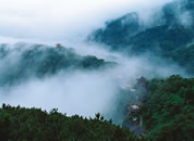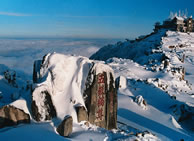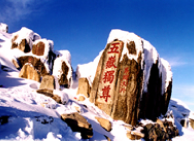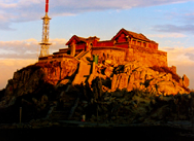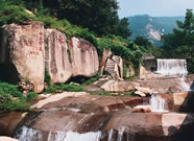|
|
|
|
|
|

Brief Introduction of Mount Tai
Mount Tai locates in the middle part of Shandong province spanning two cities (Tai’an city and Jinan city) with total area of 426 square
kilometers. Mount Tai was called Daizong (means the principal mountain of China) in ancient time and then was renamed as Mount Tai in
Spring and Autumn Dynasty went by the name of Dongyue (the Sacred Mountain of East China) that ranks No.1 among the five most important
mountains in China. In 1987, Mount Tai was listed as Cultural and Natural World Heritage site and honored “World Geopark” in 2006. In
China, Mount Tai is among the first group of “National Parks of China”, the state 5A-class tourist attraction, the top 10 best National
Civilized Spot in China.
Mount Tai is well known for its spectacular, grandness, elevation, width, steadiness and massiness. The typical character of natural
scenery of Mount Tai is imposing, steepy, surprising, serene, secluded, profound, and spacious. The picturesque of the Mount Tai has
various sceneries like cragged cliff, deep canyon and gorge, grotesque peak and strange rocks, luxuriant vegetation and the flowing
springs and twittering birds…. The mountain also has the unique marvelous wonders: the rising sun at dawn, the jade plate of sea of
clouds, the aura appearing around Bixia Temple, rosy clouds at sunset etc.
Since ancient time, Mount Tai is recognized as holy and sacred Mountain and held the accolade as “Most Revered of the Five Sacred
Mountains”. Furthermore, Mount Tai symbolized the peaceful life and unified country. Four thousands of years, more than a dozen
emperors paid their homage to the mountain. Vast quantities of poetry and stone inscriptions were left by emperors, poets and scholars
of every era. Confucians and Taoists coexist harmoniously on the mountain. And civilians worshiped the mountain with sincere esteem.
In other words, the Mount Tai has becomes the symbol of Chinese spirit. There are also peculiar geologic structures as three grand
fracture layers, Komatiite rocks and Zuixin Stone (a swirl shaped allgovite rocks); masterpieces of ancient constructions as Dai Temple,
Nantian Gate, Bi Xia temple; precious stone inscriptions of past dynasties as Qin dynasty stone inscriptions, inscriptions rocks of the
Diamond Sutra, cliffs with inscriptions of Tang dynasty; ancient trees like pine trees of Qin Dynasty, cypress of Han Dynasty (about
1800 years ago), locust tree of Tang Dynasty(about 1200 years ago). All the above syncretize and integrate nature scenery and human
culture. 7000 stone stairs which runs 9 kilometers long through the mountain from the foot to the zenith looks like the axes of Mount
Tai integrating earth, heaven and human as a whole and thus is a road for human beings to heaven. Because of the unique integration
of human civilization and natural landscape, Mount Tai is respected by billions of Chinese people and becomes famous all over the world
as well as treasurable heritage of panhuman.
Ticket for entering Mount Tai
Busy season:RMB115.00 Yuan/person>
Tourism consulting:0538-96008888
E-Mail: tsjqhjfwzx@ta.shandong.cn
Tel. for fire alarm:
Scenic spot fireproofing office of Mount Tai: 0538-5369111 8225841
| Month | Day | Hour | Minute | Month | Day | Hour | Minute |
|---|---|---|---|---|---|---|---|
| 1 | 1 | 7 | 15 | 7 | 1 | 7 | 15 |
| 1 | 7 | 15 | 1 | 7 | 15 | ||
| 1 | 7 | 15 | 1 | 7 | 15 | ||
| 2 | 1 | 7 | 15 | 8 | 1 | 7 | 15 |
| 1 | 7 | 15 | 1 | 7 | 15 | ||
| 1 | 7 | 15 | 1 | 7 | 15 | ||
| 3 | 1 | 7 | 15 | 9 | 1 | 7 | 15 |
| 1 | 7 | 15 | 1 | 7 | 15 | ||
| 1 | 7 | 15 | 1 | 7 | 15 | ||
| 4 | 1 | 7 | 15 | 10 | 1 | 7 | 15 |
| 1 | 7 | 15 | 1 | 7 | 15 | ||
| 1 | 7 | 15 | 1 | 7 | 15 | ||
| 5 | 1 | 7 | 15 | 11 | 1 | 7 | 15 |
| 1 | 7 | 15 | 1 | 7 | 15 | ||
| 1 | 7 | 15 | 1 | 7 | 15 | ||
| 6 | 1 | 7 | 15 | 12 | 1 | 7 | 15 |
| 1 | 7 | 15 | 1 | 7 | 15 | ||
| 1 | 7 | 15 | 1 | 7 | 15 |
| Interzone | Stairs | Distance(m) | Altitude(m) |
|---|---|---|---|
| 1Postern of Dai Temple to Daizong Archway | no | 474 | 150~165 |
| Dai Temple Archway to Guandi Temple | no | 474 | 150~165 |
| Guandi Temple to Red Gate Palace | no | 474 | 150~165 |
| Red Gate Palace to Ten Thousand Immortals Tower | no | 474 | 150~165 |
| Ten Thousand Immortals Tower to Martyr Monument | no | 474 | 150~165 |
| Martyr Monument to Doumu Palace | no | 474 | 150~165 |
| Doumu Palace to the crossing of Sutra inscribed Stones’ Valley | no | 474 | 150~165 |
| The crossing of Sutra inscribed Stones’ Valley to East and West Bridge | no | 474 | 150~165 |
| East and West Bridge to Tai’an Monument | no | 474 | 150~165 |
| Tai’an Monument to Four Locust Trees | no | 474 | 150~165 |
| Four Locust Trees to Hutian Pavilion | no | 474 | 150~165 |
| Hutian Pavilion to Pavilion for King of Medicine | no | 474 | 150~165 |
| Pavilion for King of Medicine to Butian Bridge | no | 474 | 150~165 |
| Butian Bridge to Zhongtian Gate | no | 474 | 150~165 |
| Subtotal | no | 474 | 150~165 |
| Zhongtian Gate to the South end of highway | no | 474 | 150~165 |
| The South end of highway to the north end of it | no | 474 | 150~165 |
| The north end of highway to Cloud Disappearing Sword | no | 474 | 150~165 |
| Cloud Disappearing Sword to Yunbu Bridge | no | 474 | 150~165 |
| Yunbu Bridge to Pavilion of Five Pine Trees | no | 474 | 150~165 |
| Pavilion of Five Pine Trees to Chaoyang Cave | no | 474 | 150~165 |
| Chaoyang Cave to Pavilion of Two Aspectant Pine Trees | no | 474 | 150~165 |
| Pavilion of Two Aspectant Pine Trees to Longmen Archway | no | 474 | 150~165 |
| Longmen Archway to Shenxian Archway | no | 474 | 150~165 |
| Shenxian Archway to Nantian Gate | no | 474 | 150~165 |
| Nantian Gate to Bixia Temple | no | 474 | 150~165 |
| Bixia Temple to Carved Cliff of Tang Dynasty | no | 474 | 150~165 |
| Carved Cliff of Tang Dynasty to Qingdi Palace | no | 474 | 150~165 |
| Qingdi Palace to Jade Emperor Peak | no | 474 | 150~165 |
| Subtotal | no | 474 | 150~165 |
| Total | no | 474 | 150~165 |
Tourists by air could take airplane at the nearest airport- Jinan YaoQiang International Airport to Mount Tai. There is bus to Taishan Hotel at the airport. You could consult the details to attendants at the airport.
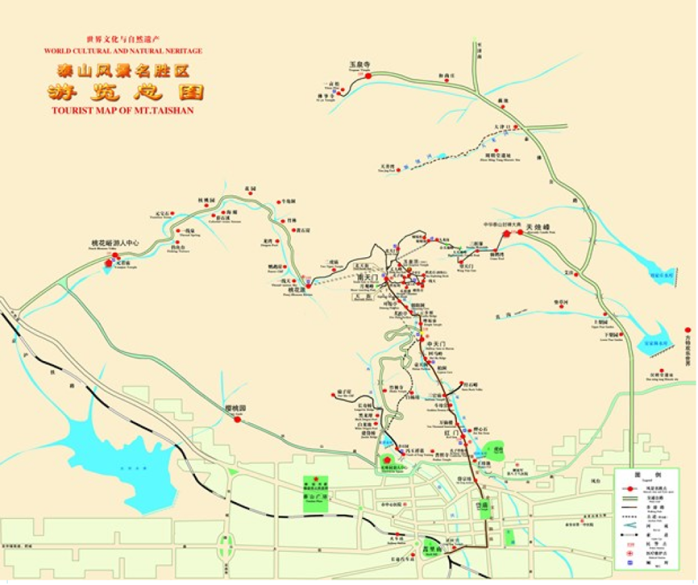
The route from Dai Temple to Red Gate to Summit of Mount Tai is an old and traditional route. It begins from Yaocan Pavilion and ends to Summit of Mount Tai, where the culture relic and natural landscape introject together along sides of the seven thousand stairs and is believed as the prime of Mount Tai.
The last stretch of the stairway from Zhongtian Gate to the peak of the Mount Tai is the best essence of the whole scenic area of Mount Tai. You will feel the shock of heart when you appreciate the majestic vigor, beautiful scenery and immemorial relic.
If you only have limited time, you could climb to Zhongtian Gate then arrive to the peak of Mount Tai by cableway in 7 minutes just like “have a skyrocketing rising”.
Through thousands of years of construction, this route is now a rather perfect route of touring. The stairs are solid and neat with temples on both sides repaired regularly and clear inscriptions, precious ancient trees wearing nameplates, clear creeks. And if you feel tired, you could come into one of tea shops or bars for a rest then you will be refreshed and then have no fatigue.
Way for touring: walk on stone steps
Scenic spots on the way: Daizong Archway, Guandi Temple, Yitian Gate, Spot where Confucius visited, Red Gate Palace, Ten Thousand Immortals Tower, monument to revolutionary martyrs, the inscription of Chinese characters for wind and moon have been written with their outside strokes omitted, symbolizing the boundlessness of the view, Temple of three views, Doumu (mother of immortal dipper) temple, Yuanjun(the highest title in Taoist) Temple, Sutra Rocks Valley, Feng’an Monument, cave of cypress, Hutian Pavilion, Huima(the horse return back) Ridge (the ridge is so steep and dangerous that the horse must stop and return back), Zhongtian Gate, Yunbu Bridge(stepping on the bridge just like walking in the sky), Five Gentlemen Pines, Guest Welcoming Pine, Chaoyang cave (the cave facing sun), the Eighteen Mountain Bends, Shengxian Archway, Nantian Gate etc.
Ticket price
The touring route of Tianwaicun begins from Tianwaicun and goes upstream along Huangxi River and passes 13 kilometers round hill roads to reach Zhongtian Gate. The route is mainly composed of natural landscape and intersperses some relics since it is vast area of Mount Tai.
The route consists of two sections: first section is round hill roads from the Heaven and earth Square to Zhongtian Gate with entire journey of about 14 kilometers; the second section is the cable trolley from Zhongtian Gate to the summit and spans 2078 meters. Tourists could view the marvelous scenery of Mount Tai from this route.
Thanks to the convenience brought by the modernized technology, to ascend the Mount Tai has turned from a trip of sweatiness to the transfer of vehicles. The road only permits the special travel bus of Mount Tai to pass through.
Way for touring: by bus, there are 3 stops: Heilong (Black Dragon) Pool, Zhulin Temple, Huangxi River. You could get off the bus to have view at any of the three stops.
Scenic spots on the way: The heaven and earth square of Tianwaicun, reservoir of Heilong pool, Bailong (white dragon) pool, waterfall of Heilong pool, Zhulin temple, Wuji temple, fan-shaped cliff, Aolai peak, Jiandai bridge, horse hoof valley, gingili oil bay, Shuntian bridge, heaven bridge, Zhongtian Gate etc.
Peach Blossom valley lies in the west side of Mount Tai, the distance from entrance of Peach Blossom Valley to Peach Blossom Origin is 13 kilometers. The landscape of Peach Blossom valley is attractive and called Peach Blossom Origin in the upper part and Peach Blossom valley in the below part because the valley was full of Peach Blossom woods in ancient time. The peculiarity of the route is accompanied by the creek water, the water on both sides of road rills and make the tourist to enjoy the delight by boat.
The route of Peach Blossom valley is convenient especially for the tourists coming along the north road.
The road permits only the special bus of Mount Tai to pass through. If you prefer walking, you could walk on foot on the 5.7 kilometers walking road in the Peach Blossom origin to satisfy your tendency of closing to nature.
There is cableway in Peach Blossom Valley to the summit of Mount Tai.
Way for touring: By bus. 5 stops: fishing platform, steel Buddha temple, creek of colorful stone, creek of red scale, plain of red rain. Tourists could get off the bus on any of them.
Scenic spots on the way: Yuanjun temple, fishing platform, steel Buddha temple, colorful stones creek, red scales creek, red rain plain, yellow stone cliff, Parrot cliff, sliver of sky, Peach Blossom Valley etc..
Travel Route: Drive 5 kilometers from Tai’an city along the national highway NO. 104 and then get to Peach Blossom valley. Along the road to Peach Blossom Land you could reach the destination by going northeast.
The section from Nantian Gate to Summit of Mount Tai is called Dai Ding (the top of Mount Tai) with an area of 0.6 square kilometers. There are 6 groups of ancient architectures, more than 22 pieces of steles or stone tablets and more than 220 petroglyphs. It is 0.8 kilometers from Nantian Gate to summit of Jade Emperor. There are culture relics and natural landscape harmonized as an integration, which is called the fine section of Mount Tai. The top of Mount Tai emblematizes the heaven, visitors pass through the celestial stairs from the human world to approach the god’s universe and experience the felling of “climbing Mount Tai likes ascending to heaven”. You will feel sun becomes nearer and clouds come lower as if you are in the welkin after you reach to the top of Mount Tai. Heavenly Street is the main access to traverse through the top of Mount Tai. Standing here, you can understand the profound philosophy in words said by Confucius “On the top of Mount Tai the whole world becomes smaller”. Furthermore, you could not only appreciate unique scenery of rising sun from the east, sunset glow, and golden strip of Yellow River and sea of cloud like jade plate but also listen attentively the myths about them.
Travel method: on foot
Scenic spots on the way: Weiliao (Endless) Pavilion, Moon observing peak, West Gate to Heaven, North Gate to Heaven, father-in-law peak, heavenly street lane, Heavenly street, elephant trunk peak, white cloud cave, dark cloud cave, famous historical site of Viewing Wu State, Confucius cliff, Triones Terrace, Bixia Temple, ZhanLu Terrace (terrace for viewing Lu State), sacrifice cliff, north arching stone, grand view peak, Most Revered of the Five Sacred Mountains, blank stele, Jade Emperor Peak etc.
Dai temple locates in the south of Mount Tai and center of Tai’an City, also called Dongyue (mountain in the east) temple, Taiyue (supreme mountain) temple, Daiyue (revered mountain) temple. It is usually called Tai Temple by common civilian. Dai Temple is main place to hold worship ceremony. There are 186 rooms established in ancient time or archaized in neoteric time. There are also 184 steles, 48 stones of Han Dynasty, 212 ancient cypresses and oriental arborvitaes, 292 kinds of ornamental plants in this temple, and it is regarded as key historical site under state protection in 1988.
Dai Temple, anterior time known as the "Dongyue Temple", also known as Tai temple, which is a place for enshrining "God of Mount Tai," and also the place for ancient emperors to live and hold worship ceremonies when they came to Mount Thai to hold mountain worship Feng Shan. Dai Temple has a long history, according to historical data of West Han dynasty (BC.206-AD.9), which was constituted after Qin (BC.771-BC.207) dynasty, and finished during Han dynasty. Unfortunately part of the building were destroyed during Jin(1115-1234) dynasty, but they are extended in Yuan Dynasty(1271-1368); and most buildings are destroyed again in Ming Dynasty(1364-1683), and during Qing Dynasty(1636-1912), it was repaired and expanded once again, and gradually took the shape of a large-scale buildings.
Tiankuang Palace is the principle part of Dai Temple and one of three most famous palatial architectures. Inside it, the towering Palaces and Nantian Gate echo each other at distance and let visitors enjoy the grace of Mount Tai.
Dai Temple is concentrated place of cultural relics. Not only oblations, offerings, and crafts were preserved here, but also archaeological finds and the revolutionary cultural relics with the flame of the Chinese civilization, and a large number of books about Mount Tai and Taoism were also found here. Especially, there are 184 pieces ancient steles and 48 pieces of painted stones of the Han Dynasty, which is the third forest of steles of China after Xi’an and Qufu. Dai Temple is also classical gardens that could be a feast for the eyes: all kinds of cypresses, high Ginkgoes, exquisite bonsais, variety of flowers, together with the elegant kiosk, buildings, and pavilions. As a whole, Lofty Dai temple is a museum of ancient art that melts buildings, gardens, sculpture, drawings and Chinese traditions together.
Ticket price: ¥20.00 / person
Time of travel: About 2 hours

Tourist Routes for Mountaineering and the Scenic Spot Introduction

World Natural and Cultural Heritage
1、Brief Introduction of Mount Tai
Mount Tai locates in the middle part of Shandong province spanning two cities (Tai’an city and Jinan city) with total area of 426 square kilometers. Mount Tai was called Daizong (means the principal mountain of China) in ancient time and then was renamed as Mount Tai in Spring and Autumn Dynasty went by the name of Dongyue (the Sacred Mountain of East China) that ranks No.1 among the five most important mountains in China. In 1987, Mount Tai was listed as Cultural and Natural World Heritage site and honored “World Geopark” in 2006. In China, Mount Tai is among the first group of “National Parks of China”, the state 5A-class tourist attraction, the top 10 best National Civilized Spot in China.
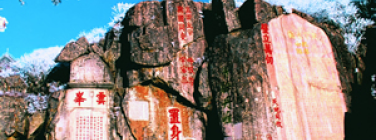
Mount Tai is well known for its spectacular, grandness, elevation, width, steadiness and massiness. The typical character of natural scenery of Mount Tai is imposing, steepy, surprising, serene, secluded, profound, and spacious. The picturesque of the Mount Tai has various sceneries like cragged cliff, deep canyon and gorge, grotesque peak and strange rocks, luxuriant vegetation and the flowing springs and twittering birds…. The mountain also has the unique marvelous wonders: the rising sun at dawn, the jade plate of sea of clouds, the aura appearing around Bixia Temple, rosy clouds at sunset etc.
Since ancient time, Mount Tai is recognized as holy and sacred Mountain and held the accolade as “Most Revered of the Five Sacred Mountains”. Furthermore, Mount Tai symbolized the peaceful life and unified country. Four thousands of years, more than a dozen emperors paid their homage to the mountain. Vast quantities of poetry and stone inscriptions were left by emperors, poets and scholars of every era. Confucians and Taoists coexist harmoniously on the mountain. And civilians worshiped the mountain with sincere esteem. In other words, the Mount Tai has becomes the symbol of Chinese spirit. There are also peculiar geologic structures as three grand fracture layers, Komatiite rocks and Zuixin Stone (a swirl shaped allgovite rocks); masterpieces of ancient constructions as Dai Temple, Nantian Gate, Bi Xia temple; precious stone inscriptions of past dynasties as Qin dynasty stone inscriptions, inscriptions rocks of the Diamond Sutra, cliffs with inscriptions of Tang dynasty; ancient trees like pine trees of Qin Dynasty, cypress of Han Dynasty (about 1800 years ago), locust tree of Tang Dynasty(about 1200 years ago). All the above syncretize and integrate nature scenery and human culture. 7000 stone stairs which runs 9 kilometers long through the mountain from the foot to the zenith looks like the axes of Mount Tai integrating earth, heaven and human as a whole and thus is a road for human beings to heaven. Because of the unique integration of human civilization and natural landscape, Mount Tai is respected by billions of Chinese people and becomes famous all over the world as well as treasurable heritage of panhuman.
2、Mountain Worship (Feng Shan)
The ceremony of mountain worship is unique old courtesy of Mount Tai, which forms the important element of apotheosis and godliness for Mount Tai. Because the ceremony was held by emperors of each dynasty, it attracted more attention and had far-reaching influence. From the legendary pre-historical period to Emperor in Song Dynasty, “Feng Shan” was a continuous traditional rite through primeval society to feudalized society.
According to the meaning in Zheng Yi written by Zhang Shoujie and recorded on historyin Shih Chi .Book of Feng Shan, “Feng Shan” is explained as “To build altar by soil on Mount Tai for returning the god of merits is called ‘Feng’; to clear the land on a hill below Mount Tai for expressing gratitude to earth is called “Shan””.
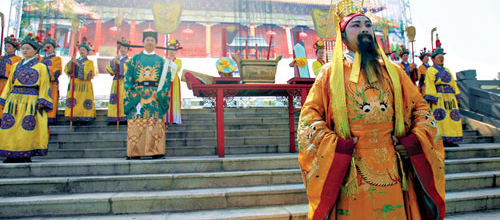
Therefore, the actual meaning of “Feng Shan” ceremony is to declare the emperor’s legitimate rule over the land and the people was in compliance with heaven’s will and to report the peace to god; moreover, to pray the blessing of the heaven. Certainly the emperor would also report how brilliant his achievement in his regality was. The connotation of the ceremony symbolized harmony between spiritual will and external behavior by harmonizing the relationship of heaven, terra, deities and humans. First emperor of Qin, Emperor Wu Di (140-87 BC) of the Western Han dynasty, Emperor Gaozong (650-683) of Tang dynasty, Emperor Xuanzong(r. 712-756) of Tang dynasty, Emperor Zhenzong of Song dynasty had ever held “mountain worship” ceremony “Feng Shan”. After Emperor Zhenzong, the posterior emperors came to Mount Tai only held sacrifice and didn’t hold “Feng Shan” anymore.
3、Mountain Worship (Feng Shan)
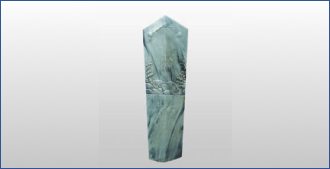
The reign of Emperor Qianlong in Qing Dynasty
The jade was bestowed by empress dowager in 36th year of reign of Qianlong which is 92.5cm long and 29.5cm wide composed of two parts. The upper part embossed three circles connected by curve separately representing sun, moon and stars and sea water and cliff on the lower part. Another part has intaglio of “Qian Long Nian Zhi” meaning produced in reign of Qianlong emperor. The jade is in cyan.
“Wen Liang Yu Gui” – A Jade Tablet for ritual services
The reign of Emperor Qianlong in Qing Dynasty
wo lions carved from agalloch eaglewood are of 37.5cm high and 36.5cm long, which were bestowed by Emperor Qianlong in 27th year of his reign. The lions’ forelegs keep upright sitting on their buttocks and the tails cocked. The lumps on the surface are similar to the curled fur. Their eyes open wide and shine vigorously and the mouth opens slightly to reveal the soigné teeth and the stretched tongue.
Lions Made of Agalloch Eaglewood
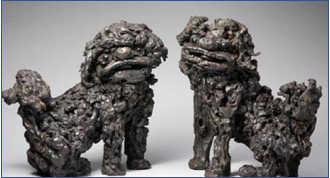

The reign of Emperor Qianlong in Qing Dynasty
The vase is 22.5cm high with caliber of 3.1cm and bottom diameter of 6.3cm. It was conferred to Dai Temple by Emperor Qianlong of Qing Dynasty in 52nd of his reign. Its cover is hemicycle with a knob like mushroom and adorned with picture of 3 pieces of cyan clouds. There are 3 blossoms of lotus twined together in twigs, 9 blossoms of plum in corset, and 4 blossoms of lotus in below surface and inscribed “made in Jiajing Year” on the bottom. The cyan pigment is typical turn cyan color and the porcelain is exquisite porcelain of Guan ware of Jiajing.
Yellow Glaze Calabash Vase with Green Flowers
4、Wonders on Mount Tai
(1) The rising sun at dawn
The sunrise on Mount Tai is splendid and one of the marvelous spectacles of the summit of Mount Tai and is also the important symbol of Mount Tai. While the first beam of sunlight tears the last beam of darkness before dawn, the east sky turns dull black to grey, to red and then to dazzling golden yellow jetting out rays of morning sun and brightening the whole sky. Finally, one fireball suddenly jumps out of sea of cloud. The whole process is like a peak of perfection which likes thousands of polychrome pictures brought by a lofty magician.

(2) The rosy clouds at sunset
The sky clears after rain and the sun falls down to the west, if you amble on the peak of Mount Tai and look up the sky: the golden rays penetrate layers of clouds and dyed the clouds into golden rosy and shaped like gleaming apex. And all the cloud peaks are beset by golden selvage and flickering the blaze of precious jewellery. Just as portrayed in the poem: “Sky is painted into rosy and golden, who is holding an colorful pen to limn the sky”; “limpid spring water rushes down myriad of cliffs, glowing sunset drives thousands of peaks”.
(3) The aura on Mount Tai
The aura on top of Mount Tai is another one of wonders. When cloud and mist are diffusing in the early morning or nightfall, the aura emerges on the dimly clouds if tourists look down from a higher summit in the same direction of the light. The aura is one colorful halo with blue color inside and red color outside and reflects an image of a person just like the aura surrounds the Buddhist statue. That’s why called “Fuo Gang” (aura) or “Bao Guang” (jewellery light). The aura on Mount Tai is one kind of light diffraction and appears only under the whether condition of sunny with fog and the sunlight slanting in June to August.
(4) Jade plate of sea of clouds
The view of unfurling Jade plate of sea of clouds surrounding the summits is another one gorgeous wonder on top of Mount Tai. In summer, when sun comes out just after the rain, mass vapor vaporized to the sky, and the warm air from sea is lofty above about 1500 meters high and there is no wind, looking from the summit of Mount Tai, you could see white clouds tiling to thousands square meters as white jade plate suspending between earth and heaven. All forane hills are engulfed in the clouds and only few of them emerged; visible tourists like to step on the cloud as if they came to heaven. While breeze blowing, the cloud waved like sea water and the hills conceal and emerge as mysterious fairy islands; while the wind becomes strong, clusters of clouds turn into gigantic dragon flying up and down and thus agitate the sea of cloud.

Routes For Mountaineering and the Scenic Spot Introduction
Mount Tai locates in the middle part of Shandong province spanning two cities (Tai’an city and Jinan city) with total area of 426 square
kilometers. Mount Tai was called Daizong (means the principal mountain of China) in ancient time and then was renamed as Mount Tai in
Spring and Autumn Dynasty went by the name of Dongyue (the Sacred Mountain of East China) that ranks No.1 among the five most important
mountains in China. In 1987, Mount Tai was listed as Cultural and Natural World Heritage site and honored “World Geopark” in 2006. In
China, Mount Tai is among the first group of “National Parks of China”, the state 5A-class tourist attraction, the top 10 best National
Civilized Spot in China.
Mount Tai is well known for its spectacular, grandness, elevation, width, steadiness and massiness. The typical character of natural
scenery of Mount Tai is imposing, steepy, surprising, serene, secluded, profound, and spacious. The picturesque of the Mount Tai has
various sceneries like cragged cliff, deep canyon and gorge, grotesque peak and strange rocks, luxuriant vegetation and the flowing
springs and twittering birds…. The mountain also has the unique marvelous wonders: the rising sun at dawn, the jade plate of sea of
clouds, the aura appearing around Bixia Temple, rosy clouds at sunset etc.
Since ancient time, Mount Tai is recognized as holy and sacred Mountain and held the accolade as “Most Revered of the Five Sacred
Mountains”. Furthermore, Mount Tai symbolized the peaceful life and unified country. Four thousands of years, more than a dozen
emperors paid their homage to the mountain. Vast quantities of poetry and stone inscriptions were left by emperors, poets and scholars
of every era. Confucians and Taoists coexist harmoniously on the mountain. And civilians worshiped the mountain with sincere esteem.
In other words, the Mount Tai has becomes the symbol of Chinese spirit. There are also peculiar geologic structures as three grand
fracture layers, Komatiite rocks and Zuixin Stone (a swirl shaped allgovite rocks); masterpieces of ancient constructions as Dai Temple,
Nantian Gate, Bi Xia temple; precious stone inscriptions of past dynasties as Qin dynasty stone inscriptions, inscriptions rocks of the
Diamond Sutra, cliffs with inscriptions of Tang dynasty; ancient trees like pine trees of Qin Dynasty, cypress of Han Dynasty (about
1800 years ago), locust tree of Tang Dynasty(about 1200 years ago). All the above syncretize and integrate nature scenery and human
culture. 7000 stone stairs which runs 9 kilometers long through the mountain from the foot to the zenith looks like the axes of Mount
Tai integrating earth, heaven and human as a whole and thus is a road for human beings to heaven. Because of the unique integration
of human civilization and natural landscape, Mount Tai is respected by billions of Chinese people and becomes famous all over the world
as well as treasurable heritage of panhuman.
The route from Dai Temple to Red Gate to Summit of Mount Tai is an old and traditional route. It begins from Yaocan Pavilion and ends to Summit of Mount Tai, where the culture relic and natural landscape introject together along sides of the seven thousand stairs and is believed as the prime of Mount Tai.
The last stretch of the stairway from Zhongtian Gate to the peak of the Mount Tai is the best essence of the whole scenic area of Mount Tai. You will feel the shock of heart when you appreciate the majestic vigor, beautiful scenery and immemorial relic.
If you only have limited time, you could climb to Zhongtian Gate then arrive to the peak of Mount Tai by cableway in 7 minutes just like “have a skyrocketing rising”.
Through thousands of years of construction, this route is now a rather perfect route of touring. The stairs are solid and neat with temples on both sides repaired regularly and clear inscriptions, precious ancient trees wearing nameplates, clear creeks. And if you feel tired, you could come into one of tea shops or bars for a rest then you will be refreshed and then have no fatigue.
Way for touring: walk on stone steps
Scenic spots on the way: Daizong Archway, Guandi Temple, Yitian Gate, Spot where Confucius visited, Red Gate Palace, Ten Thousand Immortals Tower, monument to revolutionary martyrs, the inscription of Chinese characters for wind and moon have been written with their outside strokes omitted, symbolizing the boundlessness of the view, Temple of three views, Doumu (mother of immortal dipper) temple, Yuanjun(the highest title in Taoist) Temple, Sutra Rocks Valley, Feng’an Monument, cave of cypress, Hutian Pavilion, Huima(the horse return back) Ridge (the ridge is so steep and dangerous that the horse must stop and return back), Zhongtian Gate, Yunbu Bridge(stepping on the bridge just like walking in the sky), Five Gentlemen Pines, Guest Welcoming Pine, Chaoyang cave (the cave facing sun), the Eighteen Mountain Bends, Shengxian Archway, Nantian Gate etc.
Ticket price
The touring route of Tianwaicun begins from Tianwaicun and goes upstream along Huangxi River and passes 13 kilometers round hill roads to reach Zhongtian Gate. The route is mainly composed of natural landscape and intersperses some relics since it is vast area of Mount Tai.
The route consists of two sections: first section is round hill roads from the Heaven and earth Square to Zhongtian Gate with entire journey of about 14 kilometers; the second section is the cable trolley from Zhongtian Gate to the summit and spans 2078 meters. Tourists could view the marvelous scenery of Mount Tai from this route.
Thanks to the convenience brought by the modernized technology, to ascend the Mount Tai has turned from a trip of sweatiness to the transfer of vehicles. The road only permits the special travel bus of Mount Tai to pass through.
Way for touring: by bus, there are 3 stops: Heilong (Black Dragon) Pool, Zhulin Temple, Huangxi River. You could get off the bus to have view at any of the three stops.
Scenic spots on the way: The heaven and earth square of Tianwaicun, reservoir of Heilong pool, Bailong (white dragon) pool, waterfall of Heilong pool, Zhulin temple, Wuji temple, fan-shaped cliff, Aolai peak, Jiandai bridge, horse hoof valley, gingili oil bay, Shuntian bridge, heaven bridge, Zhongtian Gate etc.
Peach Blossom valley lies in the west side of Mount Tai, the distance from entrance of Peach Blossom Valley to Peach Blossom Origin is 13 kilometers. The landscape of Peach Blossom valley is attractive and called Peach Blossom Origin in the upper part and Peach Blossom valley in the below part because the valley was full of Peach Blossom woods in ancient time. The peculiarity of the route is accompanied by the creek water, the water on both sides of road rills and make the tourist to enjoy the delight by boat.
The route of Peach Blossom valley is convenient especially for the tourists coming along the north road.
The road permits only the special bus of Mount Tai to pass through. If you prefer walking, you could walk on foot on the 5.7 kilometers walking road in the Peach Blossom origin to satisfy your tendency of closing to nature.
There is cableway in Peach Blossom Valley to the summit of Mount Tai.
Way for touring: By bus. 5 stops: fishing platform, steel Buddha temple, creek of colorful stone, creek of red scale, plain of red rain. Tourists could get off the bus on any of them.
Scenic spots on the way: Yuanjun temple, fishing platform, steel Buddha temple, colorful stones creek, red scales creek, red rain plain, yellow stone cliff, Parrot cliff, sliver of sky, Peach Blossom Valley etc..
Travel Route: Drive 5 kilometers from Tai’an city along the national highway NO. 104 and then get to Peach Blossom valley. Along the road to Peach Blossom Land you could reach the destination by going northeast.
The section from Nantian Gate to Summit of Mount Tai is called Dai Ding (the top of Mount Tai) with an area of 0.6 square kilometers. There are 6 groups of ancient architectures, more than 22 pieces of steles or stone tablets and more than 220 petroglyphs. It is 0.8 kilometers from Nantian Gate to summit of Jade Emperor. There are culture relics and natural landscape harmonized as an integration, which is called the fine section of Mount Tai. The top of Mount Tai emblematizes the heaven, visitors pass through the celestial stairs from the human world to approach the god’s universe and experience the felling of “climbing Mount Tai likes ascending to heaven”. You will feel sun becomes nearer and clouds come lower as if you are in the welkin after you reach to the top of Mount Tai. Heavenly Street is the main access to traverse through the top of Mount Tai. Standing here, you can understand the profound philosophy in words said by Confucius “On the top of Mount Tai the whole world becomes smaller”. Furthermore, you could not only appreciate unique scenery of rising sun from the east, sunset glow, and golden strip of Yellow River and sea of cloud like jade plate but also listen attentively the myths about them.
Travel method: on foot
Scenic spots on the way: Weiliao (Endless) Pavilion, Moon observing peak, West Gate to Heaven, North Gate to Heaven, father-in-law peak, heavenly street lane, Heavenly street, elephant trunk peak, white cloud cave, dark cloud cave, famous historical site of Viewing Wu State, Confucius cliff, Triones Terrace, Bixia Temple, ZhanLu Terrace (terrace for viewing Lu State), sacrifice cliff, north arching stone, grand view peak, Most Revered of the Five Sacred Mountains, blank stele, Jade Emperor Peak etc.
Dai temple locates in the south of Mount Tai and center of Tai’an City, also called Dongyue (mountain in the east) temple, Taiyue (supreme mountain) temple, Daiyue (revered mountain) temple. It is usually called Tai Temple by common civilian. Dai Temple is main place to hold worship ceremony. There are 186 rooms established in ancient time or archaized in neoteric time. There are also 184 steles, 48 stones of Han Dynasty, 212 ancient cypresses and oriental arborvitaes, 292 kinds of ornamental plants in this temple, and it is regarded as key historical site under state protection in 1988.
Dai Temple, anterior time known as the "Dongyue Temple", also known as Tai temple, which is a place for enshrining "God of Mount Tai," and also the place for ancient emperors to live and hold worship ceremonies when they came to Mount Thai to hold mountain worship Feng Shan. Dai Temple has a long history, according to historical data of West Han dynasty (BC.206-AD.9), which was constituted after Qin (BC.771-BC.207) dynasty, and finished during Han dynasty. Unfortunately part of the building were destroyed during Jin(1115-1234) dynasty, but they are extended in Yuan Dynasty(1271-1368); and most buildings are destroyed again in Ming Dynasty(1364-1683), and during Qing Dynasty(1636-1912), it was repaired and expanded once again, and gradually took the shape of a large-scale buildings.
Tiankuang Palace is the principle part of Dai Temple and one of three most famous palatial architectures. Inside it, the towering Palaces and Nantian Gate echo each other at distance and let visitors enjoy the grace of Mount Tai.
Dai Temple is concentrated place of cultural relics. Not only oblations, offerings, and crafts were preserved here, but also archaeological finds and the revolutionary cultural relics with the flame of the Chinese civilization, and a large number of books about Mount Tai and Taoism were also found here. Especially, there are 184 pieces ancient steles and 48 pieces of painted stones of the Han Dynasty, which is the third forest of steles of China after Xi’an and Qufu. Dai Temple is also classical gardens that could be a feast for the eyes: all kinds of cypresses, high Ginkgoes, exquisite bonsais, variety of flowers, together with the elegant kiosk, buildings, and pavilions. As a whole, Lofty Dai temple is a museum of ancient art that melts buildings, gardens, sculpture, drawings and Chinese traditions together.
Ticket price: ¥20.00 / person
Time of travel: About 2 hours

UNESCO Global Geopark
Mount Tai’s World Geopark locates in the Midwest of Shandong province, stands in the east of North China plain. Mount Tai plucks up from the groups of mountains in middle south of Shandong province and shows grand and gallant scene and boundless vigor. With more than 5000 years’ history of civilization and numerous historic/culture sites preserved behind, Mount Tai has become the epitome of history and culture of the Chinese nation and was first authorized World culture and nature heritage by UNESCO.
Mount Tai is well known for its longtime evolvement in geology, perplexing geologic structure and representative geologic vestige and always attract the attention of domestic and abroad geologists. It is the earliest one of typical areas for study the geology of Cambrian Period and is the standard area to form the evolvement frame of the geology of Cambrian Period. The standard section of the geology of Cambrian Period in Zhangxia (a county’s name) is full developed in all time’s stratum and revealed clearly what has outstanding representativeness. It contains abundant fossils of trilobite and other ancient creatures and is the primary comparative basis of regional stratums and international Cambrian system within different geological structure in Cambrian Period, which is why Mount Tai has profound position in history of geology. The neotectonic movement played an import role in the formation of Mount Tai and affected greatly the natural landscape of Mount Tai.
Mount Tai with grand shape and wide foundation make people have an expression of skyscraper, massiness and steadiness; high pines, ancient cypresses, huge rocks all give prominence to the grandeur image of Mount Tai. Lofty spirit, glorious culture and time-honored human landscape combine as a whole with natural landscape, which contributes to the special integrated sceneries of Mount Tai with higher value, richer contents and interpenetration of nature and culture.
Mount Tai’s World Geopark is composed of the following eight geological relics: geological relic scenic spot of Red Gate, the Zhongtian Gate, South Gate to Heaven, Rear Rock Basin, Peach Blossom Valley, Culai mountain, Lotus mountain and Taoshan geological relic scenic spot etc. It has a total area of 177.6km2 with abstruse and extensive contents especially in terms of the geology of Cambrian Period and standard section of Cambrian Period, neotectonic movement as well as physiognomy. All the above have significant importance in geology and are deemed as natural geological museum.



Special Local product of Mount Tai
1.Red Squama Fish of Mount Tai
It is the well known traditional dish. With another name stone scale fish, red squama fish of Mount Tai is a rare kind of wild fish living in deep water of Peach Blossom Valley and Rock Basin of Taishan. It is only 10cm long and as thick as a pinkie but very dedicate and fresh taste and contains high percent of proteid and fattiness, which is extremely delicious without any fishy smell.
Tracing back to First Emperor of Qin Dynasty, all emperors would climb Mount Tai to hold grand ceremonies to thank heaven and earth. It is said that the emperor QianLong of Qin Dynasty had been visited Mount Tai for many times and he would eat this kind of fish each time he visited. Many ancient famous poets of Tang, Song, Yuan, Ming and Qing Dynasty, for example Li Bai and Du Fu of Tang dynasty also had ever taste the fish. Therefore, Taishan red squama fish has been appreciated by more and more people since Qing Dynasty and was listed on the top first of famous food of Taishan and was popular both at home and abroad. Now visitors from China and other countries like to taste the fish when they visit MOUNT TAI. The cooking methods of the fish could be various as to boil, braise, fry or saute. But the best way to taste the flavor is to boil with water.
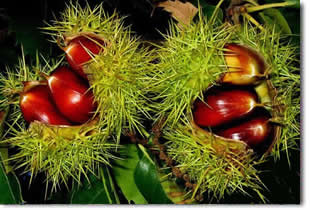

2. Small white pear of Mount Tai
It is also named beauty pear and is produced in northern foot of Mount Tai. It becomes ripe earlier and well-shaped with bright color. Its pericarp is thin and sarcocarp is tender, and also it is succulent and fragrant. Moreover, it contains malic acid, citric acid, dextrose, fructose, carrot and various Vitamins, owning functions of cleaning away the heart fire, moistening the lung, relieving a cough and lowering the blood pressure.
3.Chestnut of Mount Tai
It is also called bright chestnut and is mainly produced in Mount Tai and Culai Mountain and has varieties of BoKe (thin putamina), Jian Peng, red chestnut, Wuhua (without blossom), and Song Zao Sheng (ripe earlier). Its fruit is equally in size bright in color and with thin putamina. The inner membrane is easy to be stripped. The sarcocarp is delicate and with less moisture, it is more sticky, and fragrant and sweet in taste.
It contains the following nutrient contents in each 100 gram: Vitamin A 0.24g, Vitamin B1 0.19g, Vitamin B2 0.13mg, Vitamin C 1.2g, organic acid 1.1g, nicotinic acid 1.2mg, protein 4.8g, sugar 4.4g, fat 1.5g, coarse fiber 1.2g, calcium 15mg, phosphorus 81mg, Kalium 1.7mg, caloric 209 therm. Therefore, it is choice nutrition and healthcare tonic whatever the methods of eating: raw chestnut to eat, boiled to eat, sauted to eat etc. Sauted chestnut with sugar is famous and traditional snack of Mount Tai. Besides, chestnut could be made into chestnut cake and chestnut cooky etc.

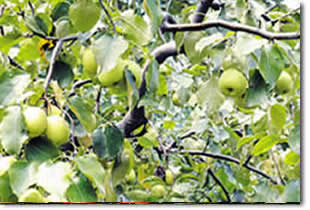
4.Big Hawkthorn of Mount Tai
Big Hawkthorn of Mount Tai has more than 3000 years’ history. The type of hawkthorn bears fruit earlier, and has high yield and strong adaptability. Its fruit is large, appearing in round or oblate shape and red color. It tastes good and could be stored for long time. Each 100g hawkthorn contains Calcium 85mg, Vitamin C 89mg as well as plenty of elements such as iron, phosphorus, protein, fat, red edible pigment and pectin etc.
Fresh hawkthorn tastes both acid and sweet. In addition, it could be made into hawkthorn cake, hawkthorn juice and cans. Furthermore, it has officinal use to cure dyspesia, fullness and distension in the pleuro-abdomen, hernia and menoschesis due to blood stasis etc. Farmers always drink the leaves of hawkthorn tree instead of tea, which is good for ameliorating the symptom of headache, vertigo and lowering cholesterin and blood pressure and preventing coronary heart disease.
5. TaiShan Walnut (Hetao)
Walnut (Hetao) also called “Hutao” has more one thousand years’ history. Taishan walnut has various types and the best type is “JiZhua (chicken toe) Mian(soft)” for its branches interlace just like chicken toe. Taishan Walnut can adapt to environment easily and has oval shape and slick surface. It is pellicular with thick sarcocarp and its fructification is over 40%. Taishan Walnut contains 60-70% fat, 15-20% protein, 10% carbohydrate and many kinds of Vitamins and mineral substance. It could be eaten directly or made into oil or industrial oil, and also could be used as medicine. In tradition Chinese medicine, the walnut mixed together with other medicine could cure lumbago caused by deficiency of kidney, continuous cough because of deficiency syndrome of lung, asthma, constipation, weakness after diseases etc. Regularly enjoying the walnut could nourish the brain, solid the teeth, black the hair and moisturizing the intestine.


6. Codonopsis Lanceolata of Mount Tai
Codonopsis Lanceolata, alternate named Lance Asiabell Root, is one of famous herbal medicine of MOUNT TAI. It belongs to Campanulaceae renascent herbs and grows in the gap of rocks, moist valley or brae covered with shadow of trees. Its tendril is about 1 meter and has single flower and opposite four leaves that is why it called Codonopsis Lanceolata. It is as large as carrot with coarse black and yellow skin. It has functions of cleaning away heat and toxic material, eliminating phlegm and releasing cough and makes physique sturdy. Dipped in white spirit, it could help to relax the muscles and stimulate the blood circulation as well as keep fitness and replenish vital energy so that it is honored as “treasure of MOUNT TAI”.
7. Lithospermum of Mount Tai
It is one of famous herbal medicines which belongs to borage family perennial herbal plant. It is very rare and grows in forests of MOUNT TAI and.
Its root could make into medicine and has such functions as invigorating blood circulation, cooling blood, clearing away heat and toxic material, diuresis and lientery with healing effect superior to the same kind of products.
8. Polygonum multiflorum
It is one of four famous herbal medicines of Mount Tai which belongs to root class medicine.
Its alternate name is red polygonum and it mainly grows in the Getiao Valley of MOUNT TAI. The root is polygonum multiflorum. Raw polygonum multiflorum tastes bitter and cold with such functions as clearing away hot and toxic material and nourishing Yin and defecation. Prepared polygonum multiflorum tastes sweet-puckery and tepor with such functions as invigorating kidney essence, aiding liver and blood, black the hair, curing symptoms of unhealthy physique, early graying hair and blood deficiency etc..
Modern medical research proved that the root of polygonum multiflorum contains lecithin and ramification of anthraquinone, which could reduce cholesterin, make cardiac muscle excite, facilitate to form glycogen and nourish nerve and blood corpuscle, and could cure neurasthenic, dysfunction of autonomic nerve, arteriosclerosis, high cholesterin in blood and anemia ect. The caudex of polygonum multiflorum has the effect of raising the heart and tranquilizing the mind, and is able to cure such symptoms as insomnia with weakness and irritability, horrified and much dream etc..
9. Polygonatum Canaliculatum
It is also one of famous herbal medicines of Mount Tai which belongs to caudex medicine.
It belongs to liliaceae perennial herbal plant and mainly grows in the DouMu Palace etc. as well as mountain valleys of northeast foot of MOUNT TAI. The Polygonatum Canaliculatum produced here is in excellent quality. Its root and caudex that should be grubbed in Spring and Autumn can be made into medicine. It tastes bitter and is neutral in nature with functions of reinforcing the spleen, moistening lung and promoting body fluid production, and is applied to weak health after a serious illness. It can also calm cough due to lung dryness and release thirst in throat because of stomach heat.
Marvelous Pictures
